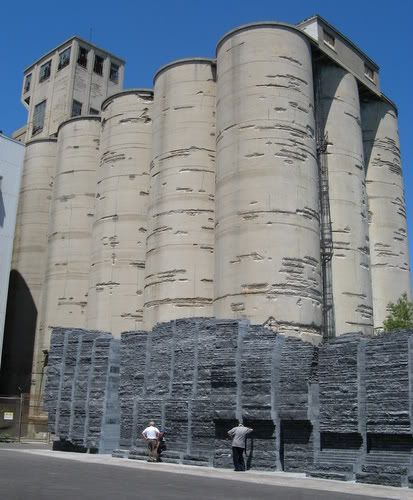
Only two weeks after HtO Park opened to the public, another public space opened with a very different purpose and spirit than the urban beach. Ireland Park was dedicated on June 21, and I took the opportunity of visiting two days later. In the latest Water issue of Spacing, contributor Paul French gives a much more detailed article on Ireland Park.
The park, is in the memory of the 160th anniversary of the arrival of immigrants fleeing the Irish Famine. Nearby, “emigrant sheds†were established to receive the 38,560 Irish that arrived in Toronto in 1847. Of those, over 1,100 died, while 675 names are known and displayed between several rough slabs, made of imported Kilkenny limestone. Five bronze statues stand (and in one case, lie) on a lawn nearby, signifying the mixed emotions and experience of the new immigrants, in a collective called “The Arrival”. In a similar park in Dublin, there are seven statues collectively called “Departure” — illustrating the loss of many ailing émigrés on the long voyage to Canada.
The location for the park is very interesting. To the west is the ferry terminal for the controversial Island Airport. Directly to the north is the city-owned abandoned Canada Malting Silos, for which many uses have been proposed, but none have been brought to life. However, the industrial silos make for a surprisingly fitting backdrop, which seems to be built into the park, the glass brick tower seemingly making reference to the silos behind it.
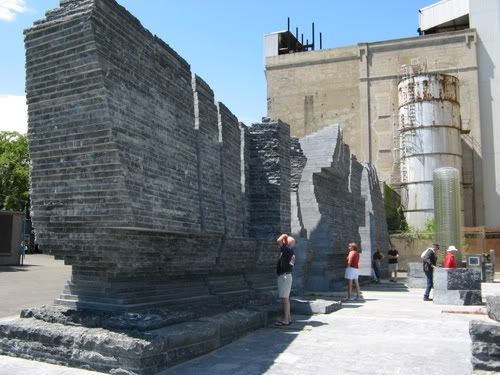
The airport, immediately across the Western Gap, is noisy. While no Porter flights were taking off or landing, the helicopters (one with a banner for a bank’s credit card, a completely wasteful way to advertise) and private planes were loud enough, but not entirely disrupting. A party boat, with dance music blaring through as it crept through the Western gap was a much greater intrusion.
This park also opens up a new vantage point for views of the rest of the waterfront. Between here and York Street, the Toronto Music Garden, the Spadina wetlands, the incomplete HtO Park, the Harbourfront Centre all are visible, and an interesting view of the downtown skyline.
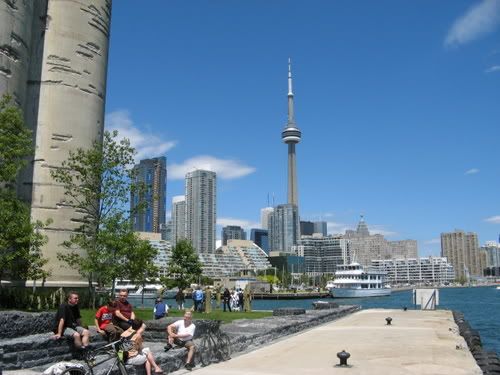
Despite the park being a bit hard to find (it is hidden behind the ferry terminal and a City yard, with no signage yet pointing the way, there was a small, but steady flow of visitors, by foot or by bicycle discovering the park and interacting with its features.
A website for the Ireland Park Foundation, accessible within the park by three touch-screen monitors, explains the context the history and the park’s features. It also has the names of the sponsoring organizations, individuals and corporations, who are not otherwise present on any plaques or signage — while the city only contributed the land for the project.
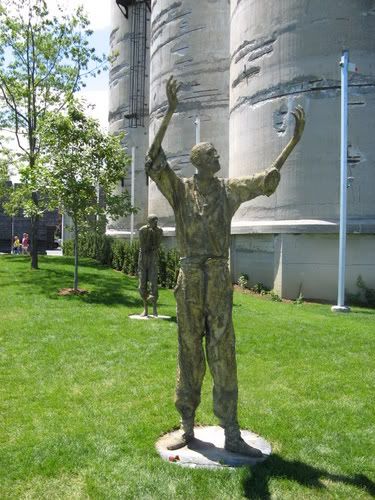


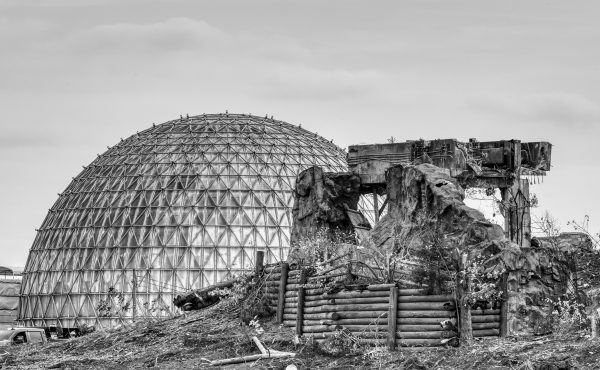
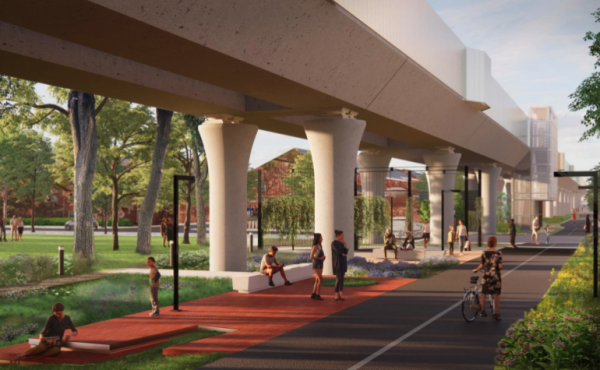
8 comments
It’s well done, but I found it fairly sombre — a couple of the sculptures are quite tragic. Unlike most parks, I can’t imagine having a picnic there (HtO would be a far more appropriate choice).
The location is very exposed to busy harbour traffic (the Western Gap forces boats to pass close to the park) but this seems fitting more than anything else. Toronto must have felt chaotic and a bit confusing to those arriving in 1847, and at this spot it still feels that way today.
I certainly echo the earlier remark on the sombreness of the park. Its pretty tough to come away from the experience uplifted. There is a sense that the figures at the park can see the city, but it remains distant from them. It was tough to find the park yet, There was a steady stream of visitors when we were there and this was impressive.
I came away troubled however – not just by a message that should leave one troubled, if not provoked to thought or action – but that this park is meant to be stuck away where it cannot be widely appreciated without an effort to find it.
There is a sense that this park has been squeezed into available space. While it certainly is newly opened, the lack of signage to get you there and the fact that you have to cross a no-trespassing sign to do so is strangely forbidding. The close quarters may echo the confines of the coffin ships that made it to Grosse Isle, but my sense is that just as the names of those victims inscribed on the limestone seems to fall between cracks, this park may as well.
I applaud the connection that is made by the Irish Park Foundation to the present day victims of the same circumstances throughout the world. This is a splendid contribution to the memory of the Irish contribution to this country and so apropos that is was dedicated so close to Canada Day.
I was a little angered by this memorial.
It seemed as though this experience is presented from outside the famine experience of the immigrants themselves. It doesn’t seem to capture the essence of what the immigrants would have felt. I did not feel that spirit of the immigrants was presented in these sculptures. What if a person were to experience these images and figures and could not read, or the power was off on the LCD panels. Would this suggest Irish to them? No. The image of the Celtic cross was an important part of life, even if not a devout and daily practicing Catholic or even Protestant Irish for that fact. It was still an image representative of a nation (or one to be) a community that these people cast into a new land would have clung to. The slabs of stone felt more like a Holocaust memorial for some reason. While the experience of the famine immigrants was a human one and not necessarily a national one, there is a sense that nationalism or at least a home left behind were an important aspect of the life that we are trying to memorialize. That this seems lost in a tucked away urban space that is somehow disconnected from past experience and the present city leaves one feeling sterile. Despite the fact we are dealing with tragedy and death, it was also an experience full of life and of people striving to better themselves and their existence in a new land. This seems lost. The park left me feeling that these people’s loss was a dead end and that it misses the point of expressing to me the survival as well. The lyricism of the Irish spirit is lost in this experience, one is left feeling a little emotionally dry.
I have been to the park twice but it was difficult to find. On both occasions people expressed their disappointment in the park but it opened dialogue. This park somehow lacks something with which to connect.
Some of the things I heard discussed:
1. Names were difficult to read, photograph and more important touch. If you were looking for specific names it was a chore as the pillars were too close together.
2. Glare on computer screens made them hard to read
3. many older people are intimidated by computers
I found the park easy enough as i knew i had to keep walking towards the huge silos of the malting factory. The park was exactly as i imagined. The statues clearly depicted the tragedy and state of the people who landed here during the famine. However, I could not read the computer screens as they were covered in dirt froma previous rain storm. I think the idea of putting celtic cross in the park is a good one as without access to the computer screens it is hard to know that these statues represent the Irish immigrants of the time. At least a written plaque would be better then the computer screens.
Otherwise it is in a great spot, could be bigger as all parks could, and it is a much needed memorial to those who suffered through the famine.
I like the park. Was disapointed the computers where not working
Stan G
I had a lot of trouble finding the park even though I knew it’s approximate location.There are two entrances,one with a no trespassing sign,the other with a “danger do not enter” sign.Someone needs to rectify this.
I found it today with minimal effort (effort nonetheless though). While the names were difficult to read it did make you realise how the names can get lost in the cracks (like someone above said) but also how difficult it is to find the records of those who parished. The article says that there is a similar park in Dublin with like-statues however it is not a park but rather on the boardwalk on the north Quays and is very much in the open and in fact quite in your face if you are not expecting to find them adding to the effect. (the sick children and dog are reminders that EVERYONE suffered).
I am still conflicted about the industrial surroundings…not sure if it is appropriate or not. But at least there is something.